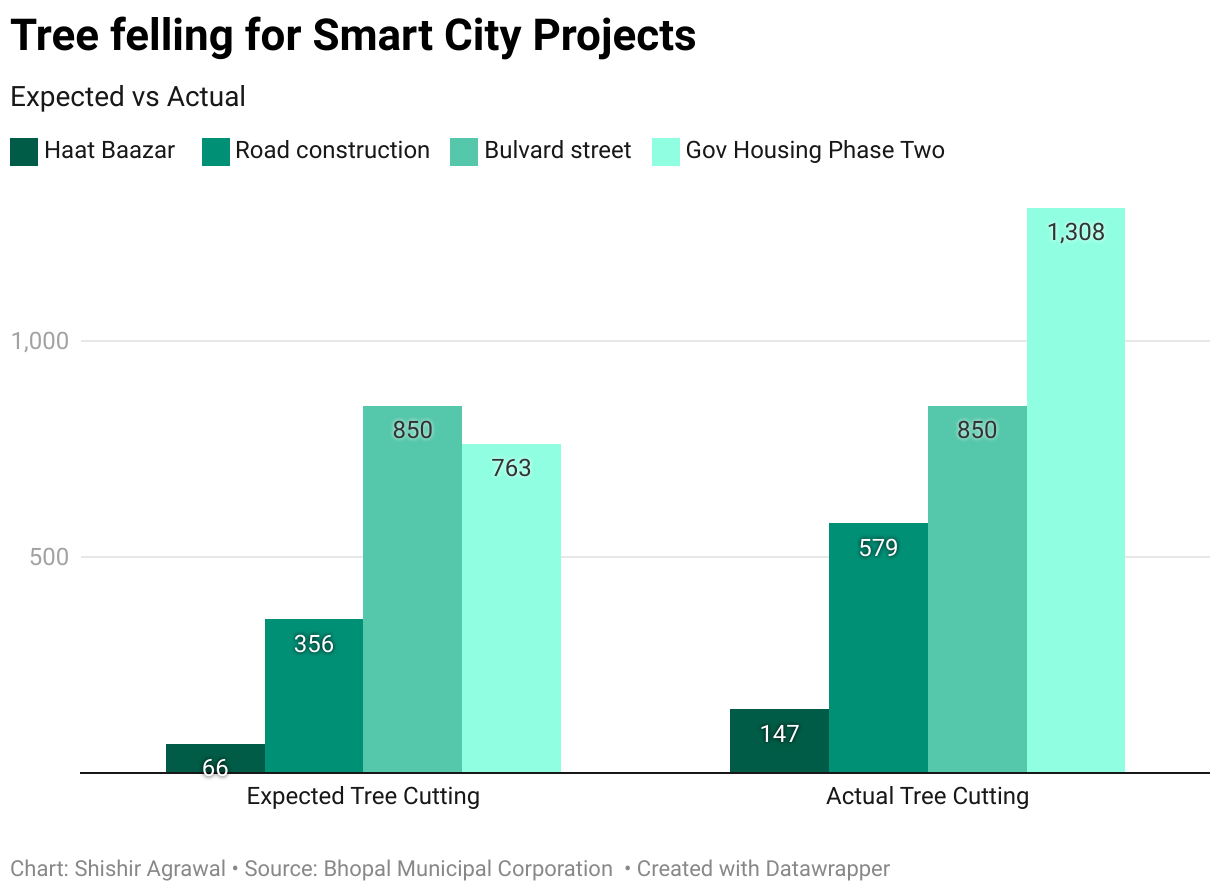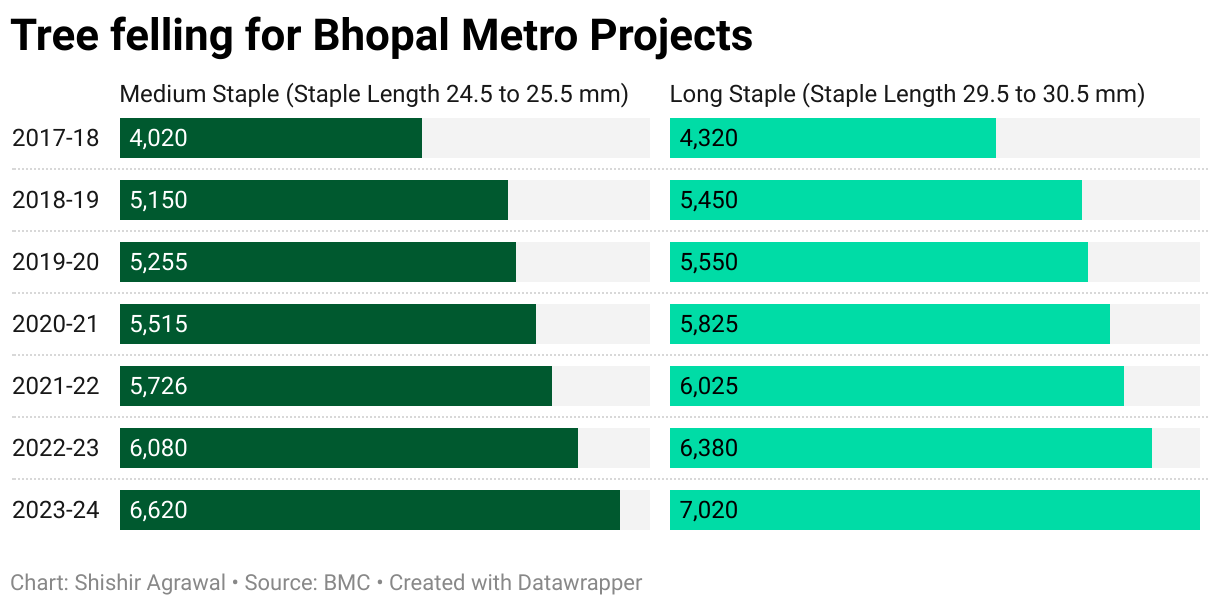About 29 thousand trees are to be cut to build government bungalows in Bhopal. These bungalows of ministers and officials are to be built in Shivaji Nagar and Tulsi Nagar of the city. These are the same areas where construction work was to be done earlier under the Smart City Project. However, due to the cutting of trees, it was later shifted to TT Nagar. Now once again the administration wants to ‘level’ this area.
On this occasion, Ground Report got the data of Bhopal tree cutting for two important projects like Smart City and Metro through the Right to Information. Along with this, we also assessed the impact of these cutting trees through experts.
Previously as part of the Bhopal Smart City initiative, a total of 2,884 trees have been felled for four sub-projects. Similarly, 3,101 trees were cut down for the metro rail project. Data obtained under the Right to Information Act reveals that the highest number of trees cut down for the metro rail construction—1,555 trees—occurred along the line from AIIMS to Subhash Nagar Crossing.
Losing Green Cover
Under the Smart City Mission of 2015, seven cities in Madhya Pradesh were supposed to be developed as smart cities. Bhopal is one of these seven cities. According to documents obtained, Tata Consulting Engineers, authorized for this project, earmarked 6,080 trees for felling. However, upon scrutiny of the documents, it was revealed that more trees were cut down than the estimated number.
For instance, for the construction of Haat Bazaar under the Smart City Development Corporation, an estimated 66 trees were expected to be cut for a cost of Rs. 34,34,16,984 in the TT Nagar area. However, the actual number of trees cut for this sub-project was 147. Similarly, the construction of government quarters in the TT Nagar area led to the felling of 1,308 trees, the highest in any sub-project.
Trees cut for the metro
According to the data obtained, it was estimated that a total of 1,877 trees would be cut for seven sub-projects under the metro project, including the construction of rail lines, metro stations, depots, and electrical substations. However, the actual number of trees cut was 3,101.
Under this project, the highest number of trees (1,555) have been cut for laying the metro rail line from AIIMS to Subhash Nagar Crossing. It is noteworthy that only 2,884 trees were cut under the Smart City projects. Therefore, from an environmental perspective, the arrival of the metro in Bhopal seems to be more costly than its Smart City transformation.
These trees being cut in the city have had a direct impact on the temperature here. The seasonal temperature of Bhopal has increased. In such a situation, the Urban Heat Island (UHI) effect has increased in the city due to the decrease in the number of trees. Also, due to this, the land surface temperature has increased. These factors have made the heat in Bhopal more unbearable and deadly.
Rising temperatures linked to deforestation
Typically, Bhopal sees May temperatures fluctuating between 40 to 41 degrees Celsius. Yet, on May 26th, the mercury spiked to 45.4 degrees Celsius. Durga Salve, a 55-year-old domestic worker residing in the Shahpura and Trilanga neighborhoods of Bhopal for the past 35 years, reflects on the change,
“This level of heat is unprecedented for Bhopal. It’s never been this intense before.”
The trees permitted to be cut down under the Smart City by the Municipal Corporation were dense and provided shade. For example, under the Smart City, roads were constructed from Roshanpura Chowk to South TT Nagar. Permission was sought to cut down 356 trees for this.
“Wherever there are trees in the city, the government considers it vacant land. Therefore, cutting down trees and building roads or buildings there doesn’t bother them,”
says a municipal employee, speaking on condition of anonymity.
The trees which were allowed to be cut by the Municipal Corporation under the Smart City were dense and shady trees. For example, a road was constructed from Roshanpura crossing to South TT Nagar under the Smart City. For this, the Smart City Authority had sought permission to cut 356 trees.

The official shares that among the felled trees, 102 were Satpura (Alstonia scholaris). Additionally, 48 Mango trees and 42 Ashoka trees, both of which provide significant shade, were cut down. These trees not only provided shade but also sheltered various creatures, including insects.
But the disappearance of these shade-providing trees and the construction of concrete structures there make the city hotter. Dr. Divya E. Surendran, a scientist at the Indian Meteorological Department (IMD), explains.
“Trees are most crucial for absorbing carbon dioxide and providing shade. These two factors help reduce the Urban Heat Island effect and also lower the land surface temperature.”
Rising land surface temperature
Durga walks for about an hour every afternoon from her home in Bharat Nagar to Trilanga. But the absence of trees on the way and the rising temperature make this path impassable. She says that she has fallen ill twice in the last 10 days due to the heat.
According to the Center for Science and Environment, the increase in seasonal temperature, ground surface temperature, and humidity in cities has made the heat in cities more deadly. The shady trees of Bhopal used to prevent the ground surface temperature from rising. But due to their cutting, the ground surface temperature of the city has also increased.

Dr. Mohammad Husain Meer, a meteorologist, explains that the rising land surface temperature increases the risk of heatwaves on pedestrians.
“Pedestrians come into direct contact with the air coming from the surface. So, as the surface temperature rises, the risk of heatwave on them also increases.”
A study conducted between 2014 and 2019 shows that the dense vegetation area in Bhopal decreased by up to 22 percent. As a result, between 2014 and 2019, the maximum temperature increased by 6.81 degrees and the minimum temperature increased by 9.91 degrees. Meer explains that having vegetation saves the ground from direct radiation from the sun, which can lead to a difference of 2 to 6 degrees in the temperature.
Rising temperatures at night
After working all day, Durga now struggles to sleep well at night too. She says that even at night, relief from the heat has become difficult. It is noteworthy that the nights of May 19-20 were the hottest in Bhopal in the last two years. According to a study by the Center for Science and Environment, the Urban Heat Island effect increases the air temperature by 2 degrees Celsius in cities.
Additionally, as per the study conducted in six cities of the country, urbanization has led to hotter nights in these cities. That is, the increasing urbanization prevents these cities from cooling down at night. For Durga, who feels the increased heat even at night, the intensified Urban Heat Island effect is responsible. According to the report, the rising temperature at night prevents the human body from getting relief from heat stress, increasing the risk of death due to heat-related illnesses.
How Much Compensatory Afforestation Has Been Done?
Under the Madhya Pradesh Preservation of Trees in Urban Areas Act of 2001, it is mandatory to plant four times the number of trees that are cut down as compensatory afforestation. If an individual cannot do this due to lack of space or any other reason, they must pay compensation.
According to the rules of the Bhopal Municipal Corporation, if trees with a circumference of less than 30 cm are cut, twice the number of trees must be assessed. For trees with a larger circumference, four times the number of trees must be accounted for. Compensation is then calculated at the rate of ₹1,450 per tree, and permission to cut the trees is only granted once this amount is paid.
Under the Smart City project, a total of 2,884 trees were cut, and ₹14,160,700 was collected as compensatory payment. For the Metro project, 3,101 trees have been cut so far, with a total compensatory amount of ₹19,277,000 collected.

A municipal employee told Ground Report that no separate compensatory afforestation is done for trees cut under any project. This is covered by the planting done by the Municipal Corporation’s garden department. According to the data we received, a total of 109,338 trees have been planted by the garden department in 16 different locations over the past three years. However, the Municipal Corporation has no data on how many of these trees have survived.
But after studying the documents, it is clear that after cutting trees for every development work, instead of planting trees in return, only compensation money is given. Bhopal’s environmentalist Rashid Noor Khan raises a policy question on this,
“If any project is coming up, then planting trees on a part of its total land should be mandatory. Due to constantly giving money in lieu of trees, the city’s ‘tree-cover’ is decreasing.”
Retired Forest Department officer R.S. Bhadauria also agrees that environmental considerations are often overlooked when planning urban development. But the increasing heat often makes Durga ill, preventing her from going to work. Worried, she says,
“If I keep getting sick like this, the homeowners will fire me. Then how will we earn a living?”
Due to environmental negligence, concrete structures may be growing in cities, but in terms of the environment, the city is lagging. The temperature in our city is constantly increasing and its biggest impact is on marginalized people like Durga.
Keep Reading
How many Cheetahs are there in India?
10 Richest states of India in the year 2024 and their GSDP
10 Poorest states in India in 2024
10 Indian cities facing water scarcity in 2024
Support us to keep independent environmental journalism alive in India.
Follow Ground Report on X, Instagram and Facebook for environmental and underreported stories from the margins. Give us feedback on our email id greport2018@gmail.com.
Don’t forget to Subscribe to our weekly newsletter, Join our community on WhatsApp, and Follow our YouTube Channel for video stories.









